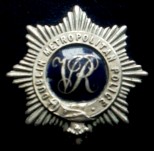Dublin Metropolitan Police
|
|
The Dublin Metropolitan Police (DMP) was the police force of Dublin, Ireland, from 1836 to 1925.
Rural policing in Ireland began when Robert Peel, then Chief Secretary for Ireland, created the Peace Preservation Force in 1816. This rudimentary paramilitary police force was designed to provide policing in rural Ireland, replacing the 18th century system of watchmen and British military forces.
In 1822, a new Act created four improved "County" Constabularies, based on the historic provinces of Ireland.
These were merged into a new centralised Constabulary of Ireland, in 1836 and the Peace Preservation Force ceased to exist. At the same time separate non-paramilitary forces were set up in the larger towns: Dublin, Belfast, and Londonderry. Discipline problems saw the Belfast and Londonderry forces absorbed by the national force, and only Dublin maintained its separate force.
The DMP was modelled closely on the London Metropolitan Police. Not only were the uniforms of the two forces almost indistinguishable, especially after the helmet and Bath Star were adopted, but the two forces also had a similar organisational structure; rather than a Chief Constable, they were commanded by a Commissioner, who was not a police officer, but a magistrate holding a Commission of the Peace. This was descended from the 18th century system of controlling parish constables, and was a sop to the public's fears about the danger of a standing police force under government control.
The DMP did not take the side of the British in the Anglo-Irish War as stridently as did the RIC, and as such did not suffer the casualty rate of that force (apart from the political "G" Division). Many DMP officers actively assisted the IRA, most famously Edward Broy, who passed valuable intelligence to Michael Collins throughout the conflict. In the 1996 film Michael Collins, Broy is discovered and subsequently tortured and killed by the British. In reality he was never caught and went on to become the Commissioner of An Garda Síochána in the 1930s.
Like those in Britain, the DMP was always an unarmed force until it was amalgamated into An Garda Síochána, which had replaced the RIC in the Irish Free State, in 1925. In this, it provided the inspiration for the first Commissioner of An Garda Síochána, who declared that the new force should be unarmed.
External links
- DMP Roll of Honour in the British National Police Officers Roll of Honour (http://www.policememorial.org.uk/Forces/Dublin/DMP.htm) (since this only covers UK forces, the DMP pages only cover up to 1922)


